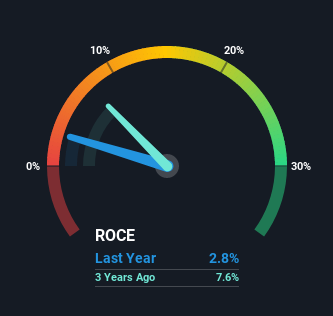- Canada
- /
- Renewable Energy
- /
- TSX:BEPC
Returns On Capital Signal Tricky Times Ahead For Brookfield Renewable (TSE:BEPC)

There are a few key trends to look for if we want to identify the next multi-bagger. Firstly, we'll want to see a proven return on capital employed (ROCE) that is increasing, and secondly, an expanding base of capital employed. Basically this means that a company has profitable initiatives that it can continue to reinvest in, which is a trait of a compounding machine. In light of that, when we looked at Brookfield Renewable (TSE:BEPC) and its ROCE trend, we weren't exactly thrilled.
What is Return On Capital Employed (ROCE)?
If you haven't worked with ROCE before, it measures the 'return' (pre-tax profit) a company generates from capital employed in its business. Analysts use this formula to calculate it for Brookfield Renewable:
Return on Capital Employed = Earnings Before Interest and Tax (EBIT) ÷ (Total Assets - Current Liabilities)
0.028 = US$809m ÷ (US$39b - US$9.8b) (Based on the trailing twelve months to June 2021).
Thus, Brookfield Renewable has an ROCE of 2.8%. Ultimately, that's a low return and it under-performs the Renewable Energy industry average of 5.6%.
View our latest analysis for Brookfield Renewable

In the above chart we have measured Brookfield Renewable's prior ROCE against its prior performance, but the future is arguably more important. If you'd like to see what analysts are forecasting going forward, you should check out our free report for Brookfield Renewable.
The Trend Of ROCE
When we looked at the ROCE trend at Brookfield Renewable, we didn't gain much confidence. To be more specific, ROCE has fallen from 7.6% over the last three years. However it looks like Brookfield Renewable might be reinvesting for long term growth because while capital employed has increased, the company's sales haven't changed much in the last 12 months. It's worth keeping an eye on the company's earnings from here on to see if these investments do end up contributing to the bottom line.
On a side note, Brookfield Renewable's current liabilities have increased over the last three years to 25% of total assets, effectively distorting the ROCE to some degree. If current liabilities hadn't increased as much as they did, the ROCE could actually be even lower. While the ratio isn't currently too high, it's worth keeping an eye on this because if it gets particularly high, the business could then face some new elements of risk.
The Bottom Line On Brookfield Renewable's ROCE
Bringing it all together, while we're somewhat encouraged by Brookfield Renewable's reinvestment in its own business, we're aware that returns are shrinking. Since the stock has gained an impressive 30% over the last year, investors must think there's better things to come. Ultimately, if the underlying trends persist, we wouldn't hold our breath on it being a multi-bagger going forward.
If you want to continue researching Brookfield Renewable, you might be interested to know about the 2 warning signs that our analysis has discovered.
While Brookfield Renewable isn't earning the highest return, check out this free list of companies that are earning high returns on equity with solid balance sheets.
If you're looking for stocks to buy, use the lowest-cost* platform that is rated #1 Overall by Barron’s, Interactive Brokers. Trade stocks, options, futures, forex, bonds and funds on 135 markets, all from a single integrated account. Promoted
If you're looking to trade Brookfield Renewable, open an account with the lowest-cost platform trusted by professionals, Interactive Brokers.
With clients in over 200 countries and territories, and access to 160 markets, IBKR lets you trade stocks, options, futures, forex, bonds and funds from a single integrated account.
Enjoy no hidden fees, no account minimums, and FX conversion rates as low as 0.03%, far better than what most brokers offer.
Sponsored ContentValuation is complex, but we're here to simplify it.
Discover if Brookfield Renewable might be undervalued or overvalued with our detailed analysis, featuring fair value estimates, potential risks, dividends, insider trades, and its financial condition.
Access Free AnalysisThis article by Simply Wall St is general in nature. We provide commentary based on historical data and analyst forecasts only using an unbiased methodology and our articles are not intended to be financial advice. It does not constitute a recommendation to buy or sell any stock, and does not take account of your objectives, or your financial situation. We aim to bring you long-term focused analysis driven by fundamental data. Note that our analysis may not factor in the latest price-sensitive company announcements or qualitative material. Simply Wall St has no position in any stocks mentioned.
*Interactive Brokers Rated Lowest Cost Broker by StockBrokers.com Annual Online Review 2020
Have feedback on this article? Concerned about the content? Get in touch with us directly. Alternatively, email editorial-team (at) simplywallst.com.
About TSX:BEPC
Brookfield Renewable
Owns and operates a portfolio of renewable power and sustainable solution assets.
Good value low.


